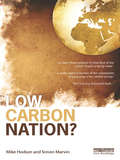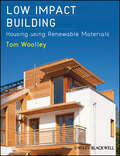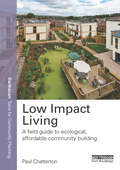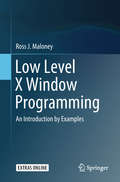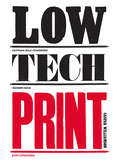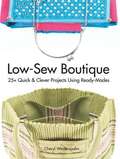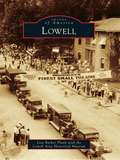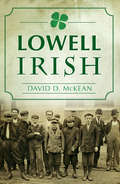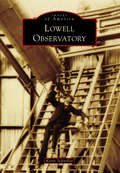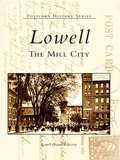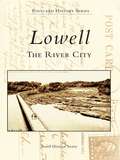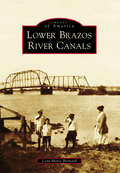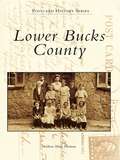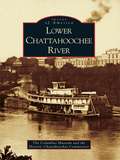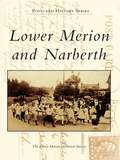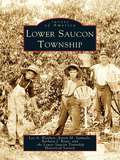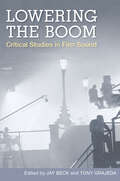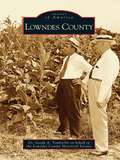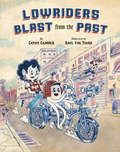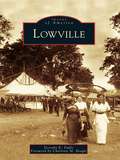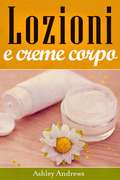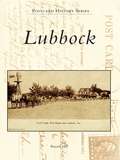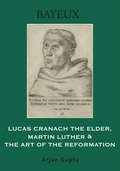- Table View
- List View
Low Carbon Nation?
by Simon Marvin Mike HodsonWhat does the transition to a Low Carbon Britain mean for the future development of cities and regions across the country? Does it reinforce existing ‘business as usual’ or create new transformational opportunities? Low Carbon Nation? takes an interdisciplinary approach to tackle this critical question, by looking across the different dimensions of technological, scientific, social and economic change within the diverse city and regional contexts of the UK. Hodson and Marvin set out how the transition to low carbon futures needs to be understood as a dual response to the wider financial and economic crisis and to critical ecological concerns about the implications of global climate change. The book develops a novel framework for understanding how the transition to low carbon is informed by historical legacies that shape the geographical, political and cultural dimensions of low carbon responses. Through a programme of research in Scotland, Wales, the North East of England, Greater London, and Greater Manchester, the authors set out different styles of low carbon urban and regional response. Through in-depth illustration of this in newly devolved nations, an old industrial region, a global city-region and in an entrepreneurial city, international lessons can be drawn about the limits and the unrealised opportunities of low carbon transition. This book is key reading for students on geography, economics, planning and social science degrees, as well as those studying sustainability in related contexts trying to understand the urban and regional politics of low carbon transition. It is also an essential resource for policymakers, public officials, elected representatives, environmentalists and business leaders concerned with shaping the direction and type of transition.
Low Impact Building: Housing using Renewable Materials
by Tom WoolleyThis guide to the designs, technologies and materials that really make green buildings work will help architects, specifiers and clients make informed choices, based on reliable technical information. Low Impact Building: Housing using Renewable Materials is about changing the way we build houses to reduce their ‘carbon’ footprint and to minimise environmental damage. One of the ways this can be done is by reducing the energy and environmental impact of the materials and resources used to construct buildings by choosing alternative products and systems. In particular, we need to recognise the potential for using natural and renewable construction materials as a way to reduce both carbon emissions but also build in a more benign and healthy way. This book is an account of some attempts to introduce this into mainstream house construction and the problems and obstacles that need to be overcome to gain wider acceptance of genuinely environmental construction methods. The book explores the nature of renewable materials in depth: where do they come from, what are they made of and how do they get into the construction supply chain? The difference between artisan and self-build materials like earth and straw, and more highly processed and manufactured products such as wood fibre insulation boards is explored. The author then gives an account of the Renewable House Programme in the UK explaining how it came about and how it was funded and managed by Government agencies. He analyses 12 case studies of projects from the Programme, setting out the design and methods of construction, buildability, environmental assessment tools used in the design, performance in terms of energy, air tightness, carbon footprint and post-occupancy issues. The policy context of energy and sustainability in the UK, Europe and the rest of the world is subjected to a critical examination to show how this affects the use of natural and renewable materials in the market for insulation and other construction materials. The debate over energy usage and embodied energy is discussed, as this is central to the reason why even many environmentally progressive people ignore the case for natural and renewable materials. The book offers a discussion of building physics and science, considering energy performance, moisture, durability, health and similar issues. A critical evaluation of assessment, accreditation and labelling of materials and green buildings is central to this as well as a review of some of the key research in the field.
Low Impact Living: A Field Guide to Ecological, Affordable Community Building (Earthscan Tools for Community Planning)
by Paul ChattertonThis book is the inspirational story of one project that shows you how you can become involved in building and running your neighbourhood. The author, co-founder of Lilac (Low Impact Living Affordable Community), along with other members of the community and the project team, explains how a group of people got together to build one of the most pioneering ecological, affordable cohousing neighbourhoods in the world. The book is a story of perseverance, vision and passion, demonstrating how ordinary people can build their own affordable, ecological community. The book starts with the clear values that motivated and guided the project’s members: sustainability, co-operativism, equality, social justice and self-management. It outlines how they were driven by challenges and concerns over the need to respond to climate change and energy scarcity, the limits of the ‘business as usual’ model of pro-growth economics, and the need to develop resources so that communities can determine and manage their own land and resources. The author’s story is interspersed with vignettes on topics such as decision making, landscaping, finance and design. The book summarises academic debates on the key issues that informed the project, and gives technical data on energy and land issues as well as practical ‘how-to’ guides on a range of issues such as designing meetings, budget planning and community agreements. Low Impact Living provides clear and easy to follow advice for community groups, practitioners, government, business and the development sector and is heavily illustrated with drawings and photographs from the architectural team.
Low Level X Window Programming: An Introduction By Examples
by Ross J. MaloneyThis is the missing X Window book. While others have shown what the X Window system has available, this book shows how to convert this potential into working tools to fulfil your visualisation needs. It is of the show-me class of books. The majority of the book covers Xlib, although a short coverage of Xcb is also given. Included are: . The relationship between Xlib and the X Window protocol; . All the basic Xlib topics are covered; . Complete working programs with their results; . Exercises to reinforce the material just covered. A 9 part partition to building a complete X program is used throughout. This partitioning fosters the inclusion of all code necessary. All programs are written in C and are one to four pages in length. Open source programs with the occasional Postscript script are shown to provide support as needed. Throughout the examples consideration is given to using colour. The examples produce simple results with the aim of providing building blocks for application oriented codes. The book is directed at graduate students and researchers who create computer code to visualise their data.
Low-Power Computer Vision: Improve the Efficiency of Artificial Intelligence (Chapman & Hall/CRC Computer Vision)
by Yung-Hsiang LuEnergy efficiency is critical for running computer vision on battery-powered systems, such as mobile phones or UAVs (unmanned aerial vehicles, or drones). This book collects the methods that have won the annual IEEE Low-Power Computer Vision Challenges since 2015. The winners share their solutions and provide insight on how to improve the efficiency of machine learning systems.
Low-Tech Print: Contemporary Hand-Made Printing
by Caspar WilliamsonFeaturing a global showcase of 100 of the craft’s most exciting and influential practitioners, Low-Tech Print is an exploration of hand-made printmaking techniques and how they are used in contemporary design and illustration. It examines the huge recent resurgence in the popularity of printmaking, with chapters on screenprinting, letterpress, relief printing and other printing methods. The book shows how practitioners develop a love affair with these hand-made techniques and use them to create beautiful contemporary designs, explaining the process behind each technique and its historical context. ‘In focus’ sections profile practitioners such as the ‘Lambe Lambe’ hand-made letterpress printers of São Paulo’s Grafica Fidalga studio and cult printing techniques such as Gocco (Japan) and Chicha (Peru).Low-Tech Print is a must-have for all design, illustration, craft and printmaking enthusiasts.
Low-Tech Print: Contemporary Hand-made Printing
by Caspar WilliamsonFeaturing a global showcase of 100 of the craft’s most exciting and influential practitioners, Low-Tech Print is an exploration of hand-made printmaking techniques and how they are used in contemporary design and illustration. It examines the huge recent resurgence in the popularity of printmaking, with chapters on screenprinting, letterpress, relief printing and other printing methods. The book shows how practitioners develop a love affair with these hand-made techniques and use them to create beautiful contemporary designs, explaining the process behind each technique and its historical context. ‘In focus’ sections profile practitioners such as the ‘Lambe Lambe’ hand-made letterpress printers of São Paulo’s Grafica Fidalga studio and cult printing techniques such as Gocco (Japan) and Chicha (Peru).Low-Tech Print is a must-have for all design, illustration, craft and printmaking enthusiasts.
Low-sew Boutique
by Cheryl WeiderspahnTime-sensitive sewing books offer more opportunities for you to enjoy your hobby more Provides sewers with a choice of 25+ individual projects most can complete in an afternoon Are you one of the many time-strapped sewers who longs for a few free minutes to work on a project? Look no further for beautiful projects you can create in an afternoon - it's all in the fresh and fun book. This book offers a fresh twist on this time-honored hobby by providing detailed instructions for transforming common household items such as placemats, towels, hot pads, pot holders and rugs, into fantastic and innovative fashion accessories. The projects in this book include backpacks, eyeglass cases, and purses, and feature skill level indicators for every level of sewer.
Lowell
by Lisa Barker Plank Lowell Area Historical MuseumSettlement of the Lowell area centered on the confluence of the Grand and Flat Rivers. Joseph and Magdaleine LaFramboise first established a fur trading post near the Ottawa village, Segwun, where the rivers meet. The community grew as settlers poured into the area attracted by the growing lumber industry and rich farmland. Diverse businesses emerged including a cutter factory, a vibrant clamming industry, and the state's oldest family-run flour mill. A unique feature of the area is Fallasburg Historic Village. Once an active mill town on the Flat River, Fallasburg slid into obscurity when the railroad passed it by. At the height of the Great Depression, businessmen of Lowell joined together to build a showboat to draw visitors to town. The Lowell Showboat is now one of the most recognizable attractions in Lowell. This book explores both well known and more obscure aspects of Lowell's history through a wealth of images, many never published before.
Lowell Irish: Stories & Accounts Of Lowell's Early Irish (American Heritage)
by David D. MckeanIrish immigrants streamed into the mills of Lowell, Massachusetts, at the start of the Industrial Revolution, fleeing poverty and later the Great Hunger. Irish families established a neighborhood called the Acre, and some rose to roles as successful business owners who shaped the history of their new home. Hugh Cummiskey emigrated from Northern Ireland to become a powerful work gang leader and businessman who in turn hired newly arrived immigrants. The first recorded celebrations of St. Patrick's Day began in 1833, as new residents celebrated their Irish roots and American future with traditional music and parades. Today, the community still honors its Irish history. From tales of politicians and entrepreneurs to the everyday struggles of the average immigrant, author David McKean traces the history of the pioneer members who established Lowell as an industrial powerhouse.
Lowell Observatory: A History Of Discovery At Flagstaff (Images of America)
by Kevin SchindlerAtop a mesa one mile west of downtown Flagstaff, Arizona, sits Lowell Observatory, an astronomical research facility steeped in tradition. Percival Lowell, scion of a Boston Brahmin family, initially established his observatory in 1894 to study the possibility of intelligent life on Mars. Lowell widely popularized his controversial theories, sparking debate among both the scientific community and lay public. In the following years, the observatory's astronomers made several discoveries that dramatically altered our understanding of space, including Clyde Tombaugh's discovery of Pluto in 1930 and V.M. Slipher's detection of the expanding nature of the universe in 1912. Decades later, Apollo astronauts visited as part of their training to fly to the moon. These stories and others offer a glimpse of the scientific discovery, community pride, and personal triumph that define Lowell Observatory.
Lowell: The Mill City
by Lowell Historical SocietyFrom its birth in 1826, Lowell has thrived, declined, and been resurrected as a mill city. Today, it is celebrated for its rich history. These postcards from the 1890s to the 1940s display the energy of this industrial city and its native andimmigrant population as it grew, built, worked, and played. Vintage cards capture both familiar mills along the Merrimack River and vanished businesses. Coupled with compelling narrative, they tell stories of a horse-drawn fire engine, textile mill workers, grand civic buildings, floods,and even the aftermath of an explosion.
Lowell: The River City
by Lowell Historical SocietyLowell, a historic industrial city, owes its life to the broad Merrimack River. Renowned for its water-powered textile mills, it was also a city rich in natural beauty, where spiritual and cultural values took root. Postcards from the 1890s to the 1940s bear witness to riverscapes, varied waterways, arched bridges, and green parks. Vintage cards depict grand churches and stately mansions, some now altered or gone, and rare interior views. Informative text accompanies the images of yellowbricked colleges, pastoral neighboring environs, dignified cemeteries, and imposing monuments, such as the captivating Lion Monument.
Lower Brazos River Canals
by Lora-Marie BernardCommunities have spent more than 100 years mastering the mighty Brazos River and its waterways. In the 1800s, Stephen F. Austin chose the Brazos River as the site for the first Texas colony because of its vast water and fertile soil. Within 75 years, a pumping station would herald the way for crop management. A sugar mill that was eventually known as Imperial Sugar spurred community development. In 1903, John Miles Frost Jr. tapped the Brazos to expand the Cane and Rice Belt Irrigation System while Houston newspapers predicted the infrastructure marvel would change the region's future--and it did. Within a few decades, the Texas agricultural empire caused Louisiana to dub Texas farmers "the sugar and rice aristocracy." As the dawn of the industrial age began, the Brazos River and its waterways began supplying the Texas Gulf Coast industry.
Lower Bucks County (Postcard History)
by Andrew Mark HermanNamed by William Penn in 1681, Bucks County is one of the three original counties in Pennsylvania and enjoys a lengthy tradition as an important region of this state. Lower Bucks County is a fascinating pictorial history of the towns that comprise the northern suburban edge of Philadelphia. Surveying the era from 1905 to 1970, the book includes images from the towns of Langhorne, Hulmeville, Trevose, Southampton, Newtown, Tullytown, Richboro, Churchville, Holland, Cornwells Heights, Fallsington, Yardley, Feasterville, Bristol, Oxford Valley, Parkland, and Andalusia. Lower Bucks County portrays the natural beauty of the area's scenery, as well as historic homes, hotels, stores, and schools. Several prominent families are also chronicled, as the county evolves into the bustling communities of today.
Lower Chattahoochee River
by The Columbus Museum Historic Chattahoochee CommissionThe Chattahoochee River has dramatically shaped the heritage of the lower Chattahoochee Valley of east and southeast Alabama and west and southwest Georgia. As the region's dominant geographic feature, the Chattahoochee has served residents of the area as an engine for commerce and as an important transportation route for centuries. It has also been a natural and recreational resource, as well as an inspiration for creativity. From the stream's role as one of the South's busiest trade routes to the dynamic array of water-powered industry it made possible, the river has been at the very center of the forces that have shaped the unique character of the area. A vital part of the community's past, present, and future, it binds the Chattahoochee Valley together as a distinctive region. Through a variety of images, including historic photographs, postcards, and artwork, this book illustrates the importance of the Chattahoochee River to the region it has helped sustain.
Lower Merion and Narberth (Postcard History)
by The Lower Merion Historical SocietyFirst settled in 1682 by William Penn's coterie of Welsh Quakers, the Lower Merion area has since undergone several transformations: from farmland, to the home of Philadelphia's industrial elite, to built-out suburb. Besides the development of the unique and impressive Main Line mansions for which the area is famous, Lower Merion and Narberth have been the scene of dramatic railroad rivalries and advances for the middle class. Lower Merion and Narberth focuses on the era of the most intense development, between 1900 and 1950, when the character of each individual neighborhood was coming into its own.
Lower Saucon Township (Images of America)
by Karen M. Samuels Lee A. Weidner Barbara J. Ryan Lower Saucon Township Historical SocietyLower Saucon Township provides a unique glimpse of the region's many diverse villages and the German immigrant population. Towns including Wassergass, Shimersville, Polk Valley, Redington, and Bingen were settled largely because of the area's fertile soil, abundant water, and many iron and limestone deposits, which contributed to surrounding communities such as Bethlehem and Hellertown both socially and economically. These rare family photographs depict a blend of lives that influenced the area before and after the industrial revolution.
Lowering the Boom: Critical Studies in Film Sound
by Jay BeckAs the first collection of new work on sound and cinema in over a decade, Lowering the Boom addresses the expanding field of film sound theory and its significance in rethinking historical models of film analysis. The contributors consider the ways in which musical expression, scoring, voice-over narration, and ambient noise affect identity formation and subjectivity. Lowering the Boom also analyzes how shifting modulation of the spoken word in cinema results in variations in audience interpretation. Introducing new methods of thinking about the interaction of sound and music in films, this volume also details avant-garde film sound, which is characterized by a distinct break from the narratively based sound practices of mainstream cinema. This interdisciplinary, global approach to the theory and history of film sound opens the eyes and ears of film scholars, practitioners, and students to film's true audio-visual nature. Contributors are Jay Beck, John Belton, Clark Farmer, Paul Grainge, Tony Grajeda, David T. Johnson, Anahid Kassabian, David Laderman, James Lastra, Arnt Maasø, Matthew Malsky, Barry Mauer, Robert Miklitsch, Nancy Newman, Melissa Ragona, Petr Szczepanik, Paul Théberge, and Debra White-Stanley.
Lowndes County (Images of America)
by Lowndes County Historical Society Dr Joseph TomberlinLowndes County, located deep in the wiregrass region of southern Georgia, has been continuously occupied since ancient times. Through the centuries, various Native American tribes inhabited the region, but they lingered relatively briefly and left few tangible traces. The area's written history began with the establishment around 1623 of the Spanish mission of Santa Cruz de Cachipile in southern Lowndes. Georgia's general assembly created Lowndes County from the southern half of Irwin County in 1825 and named it for William Jones Lowndes of South Carolina. The present county seat, Valdosta, dates from the construction of the Atlantic and Gulf Railroad across Lowndes from 1859 to 1860. Ultimately the county was to have five railroads, which, combined with U.S. Highways 41 and 84 and Interstate 75, were to be major factors in dramatic local growth."
Lowriders Blast from the Past (Lowriders)
by Cathy CamperWhen new friends Lupe, Flapjack, and Elirio are each bullied by Las Matamoscas, they know they're going to like one another. When they find out they all love lowrider cars, they know they'll be friends for life. But the bullies won't leave the Lowriders alone—and they don't let any girls or babies into car clubs. Can these three determined outcasts prove they deserve to be in the car show? Humor, Spanish words, and lowrider culture come together in this heartwarming graphic novel of three friends navigating the bumpy terrain of friendship, bullying, and standing up for what you believe in. ¡Vámonos!
Lowville
by Charlotte M. Beagle Dorothy K. DufloLowville, first settled in 1796, is part of the Black River valley, an area laden with fertile land and rich forests. The town continued to develop through the years, supporting hotels, flour mills and gristmills, furniture manufacturers, cheese plants, tanneries, and even a brewery. Lowville's place in history was sealed when, by 1878, it was producing eight million pounds of cheese annually with a value at that time of $1 million. The earlier manufacturing businesses gradually faded, and Lowville ushered in the 20th century as an important dairy center, a tradition that continues to this day.
Lozioni e creme corpo
by Ashley Andrews Elèna DeufemiaUn libro su come creare da te le tue lozioni partendo da zero. Una guida simpatica e divertente nel mondo della cosmesi e dei trucchi di bellezza alla portata di tutti!
Lubbock
by Russell HillThe city of Lubbock began as a compromise between two smaller settlements known as Lubbock and Monterey. These settlements agreed to combine on December 19, 1890, and by 1891 the combined settlement was elected the new county seat as farmers, ranchers, and settlers began to arrive. In 1909, Lubbock incorporated as a city, and the Santa Fe Railroad sent its first train south from Plainview. The Texas Legislature authorized the establishment of Texas Technological College in 1923, and Lubbock won the regional contest for the new university's location. Today Lubbock is the 10th-largest city in Texas, with an estimated population of 230,000. The Lubbock economy thrives on agriculture, education, manufacturing, and health industries.
Lucas Cranach the Elder, Martin Luther, and the Art of the Reformation
by Arjun GuptaMartin Luther's amazing courage and intellect come to life against the backdrop of paintings by Lucas Cranach the Elder, possibly the greatest artist of the European Reformation. This is the second volume in Bayeux's series entitled STORIES BEHIND THE ART.
